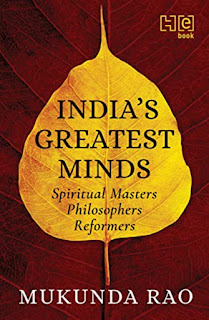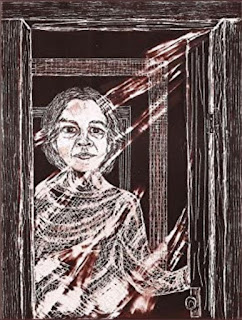The Buddha: An Alternative Narrative of His Life and Teaching
U.G. and the Natural State
Sri Aurobindo did not live long enough to complete his spiritual experiments and actualize the ‘supramental’ manifestation, and the task was passed on to the Mother. But she died before the cellular changes were brought to fruition and could find their full expression. The burden of completing the process, it seems, was passed on to U.G. Krishnamurti. Many may find such a reading strange and even problematic. It was certainly not something like passing on the baton in a relay race!
However, whether such a reading makes sense or not, the fact remains that, in 1967, five years before the Mother's death, U.G. Krishnamurti walked through that ‘just been opened door’ to undergo a full-scale biological mutation and come into the natural state.
Born on 9 July 1918 in Masulipatnam, a town in coastal Andhra Pradesh, U.G. Krishnamurti grew up in a peculiar milieu of both theosophy and Hindu religious beliefs and practices. Exposed to such knowledge at quite an early age, he developed into a passionate and rebellious character but with a strong spiritual streak in him.
It was while pursuing his BA (Hons) course in philosophy and psychology at Madras University that U.G. Krishnamurti's spiritual search gained momentum. During this three-year degree course, he spent the summer in the Himalayas studying yoga and practising meditation. At that time, he came upon certain mystical experiences. Yet, deep within him, he realized there was no transformation. It seemed he had meditated and performed penance to no avail, for he was still deeply conflicted and also found himself burning with anger all the time.
He quit university. He had decided that he wanted to attain the state of enlightenment, and nothing less would do. One day, at his friend's suggestion, he went to meet Ramana Maharshi and asked him, ‘Is there anything like moksha? Can you give it to me?’ The sage said, ‘I can give it, but can you take it?’ The counter-question struck U.G. Krishnamurti like a thunderbolt. He realized that nobody could ‘give’ that state to him; he had to find his own truth.
The next few years of his life were a roller coaster of sorts. In 1943, at the age of twenty-five, he married and started to work for the Theosophical Society in Madras (now Chennai). He also travelled extensively in India and Europe, giving talks on theosophy. The period between 1953 and 1964 was a time of great changes in him and the beginning of the metamorphosis he would undergo in 1967. In brief, he went to the US to get medical treatment for his polio-stricken son; he took up lecturing to earn a living; and he broke away from his family. After that, he began to drift aimlessly in London, a dry leaf blown hither and thither.
It was during this period that he underwent a near-death experience that altered his perception of life and eventually led him to his spiritual awakening. On 13 August 1967, on the completion of his forty-ninth year, the biological changes began to manifest. For the next seven days, seven bewildering changes took place and catapulted him into what he called the ‘natural state’.
In seven days, the whole chemistry of his body, including the five senses, was transformed. His skin turned soft, and when he rubbed any part of his body with his palm, it produced a sort of ash. His eyes stopped blinking and his senses started functioning at the peak of their sensitivity. He developed a female breast on his left side. And the hitherto dormant ductless glands such as the thymus, pituitary and pineal, referred to as chakras in kundalini yoga, were reactivated. On the eighth day, he ‘died’.
According to U.G. Krishnamurti, this was a ‘clinical’ death. He felt a tremendous burst of energy coursing through him, and all these energies seemed to draw themselves to a focal point in his body. He stretched himself on his bed and got ready to embrace death. Then a point arrived where the whole thing looked as if the aperture of a camera was trying to close itself, but there was something trying to keep it open, refusing to die. Perhaps it was the ‘I’, the residue of ‘thought’ (the fear of death, the fear of the unknown or the void, dramatized as Mara in Buddhist literature). After a while, there was no ‘will’ to do anything, not even to prevent the aperture closing itself. And it closed.
This process of dying, as U.G. Krishnamurti explained, ‘lasted for about forty-eight minutes’. His hands and feet turned cold, the body became stiff, the heartbeat slowed down and he started gasping for breath. He was seized by death pangs. All thoughts, all experiences undergone by humanity from primordial times, whether good or bad, blissful or miserable, mystical or commonplace—the whole ‘collective consciousness’—were flushed out of his system. He died on the eighth day only to be reborn in the state of ‘undivided consciousness’, untouched by thought. It was a most profound journey and a sudden great leap into the state of ‘primordial awareness without primitivism’. This was a cellular revolution, a full-scale biological mutation; it was the birth of the individual in the ‘natural state’. This was a term he chose, preferring it over the term ‘enlightenment’.
From then on, for nearly forty years till his death, U.G. Krishnamurti travelled the world. Wherever he stayed, people came to see him and to listen to his ‘anti-teaching’. He talked openly of the natural state and responded to people’s queries, answering their questions candidly, ‘revealing all the secrets’.
U.G. Krishnamurti often insisted that whatever transformation he had gone through was within the structure of the human body and not in the mind at all. Avoiding religious terms, he described the natural state as a pure and simple physical and physiological state of being. And he never tired of pointing out that ‘this is the way you, stripped of the machinations of thought, are also functioning’.
U.G. Krishnamurti turns the whole discourse upside down so that we drop our cumbersome baggage and look at the issue straight in the eye.
We cannot know the origin of thought, much less the origin of life, he asserts. What we know is that there is thought, there is desire and there is the problem of living. Thought takes its birth when there is a demand, a want; that is the wheel of becoming, becoming something other than what we are, escaping from what is there. This is the whole problem, the conflict we are caught in; this is the cause of our sorrow.
We also know that all the techniques offered to us to lead us to liberation are just various paths. And we jump from one path to another, one technique to another. But if we are ruthlessly honest with ourselves, we will know that all this helps us up to a point and then we are back to the starting point. For years we struggle through these sadhanas and yet there is no fundamental change, for the core of our being remains unchanged.
So self-inquiry or our attempt to get rid of our conditioning is not the way. It is futile and absurd, warns U.G. Krishnamurti. We cannot know the content of consciousness because it simply is too vast and deep, with millions of years of momentum behind it. It is like taking a cup to empty the ocean.
We stop there, with the awareness that the one who is looking at conditioned thought is also conditioned. Any movement away from this fact is only further conditioning. ‘You can't do a thing,’ says U.G. Krishnamurti, and it sounds hopeless and terrible, but once we understand this supreme fact we are relieved of the burden and tyranny of knowledge, of knowing that which cannot be known.
Therefore, there is no such thing as an unconditioned mind; the mind is already always conditioned. Conditioning is tradition. Tradition is the self. No matter how we may modify or tweak or shape it, it continues. ‘Every thought that is born has to die,’ U.G. Krishnamurti points out.
‘If a thought does not die, it cannot be reborn. It has to die, and with it you die. But you don't die with each thought and breath. You hook up each thought with the next, creating a false continuity. It is that continuity that is the problem … So, unconditioning yourself has no meaning, no validity. What you have to be free from is the very desire to be free from conditioning.’
Once we see this fact with the whole of our being, things fall into their natural rhythm: ‘There is nothing to do, there is nothing to control, there is nothing to ask. You don’t have to do a thing. You are finished.’
Seeing is ending. To drive home this hard-to-understand, rather mind-blowing fact is the burden of the Buddha's teaching as well. Here is what he says to Ananda:
‘Even if you succeed in putting an end to all seeing, hearing, feeling and knowing, and so preserve inner quiet, the shadow of [your] differentiation of things [dharma/samsaric phenomena] still remains.
‘I do not want you to hold that this is not mind, but you should examine it carefully and minutely: that which continues to possess discerning nature even in the absence of sense data is really your mind; on the other hand if this discerning nature ceases with sense data, this is merely the shadow of differentiation of them, for they are not permanent and when they cease to exist, so does this mind, like the hair of a tortoise and the horns of a hare. If your mind can so easily cease to be, who will then realize the patient endurance of the unborn, unconditioned?’
The mind will not cease so easily, it cannot. It is not in the nature of the mind to be quiet, to fall dead. Even during meditation it is not quiet for, as the Buddha points out, ‘the shadow of differentiation of things still remains.’ Extending the idea, as it were, U.G. Krishnamurti would say that the mind pervades the body. It is embedded in every cell. So, merely quieting the brain is not the answer. The whole organism has to become silent, and that is possible only when every cell in the body is cleansed of the mind, which has superimposed itself on the body. Only then the birth and continuity of the self, of dukkha, the bhavachakra, ceases to be.
Self-inquiry and yoga may all be necessary and valid but up to a point; after that, all these techniques become counterproductive and have to be dropped. In other words, pratitya-samutpada or any of these techniques as a method of inquiry and sadhana can loosen the grip of the ‘chain’, the self, but cannot break the chain or stop the wheel of becoming. The very search must end, the mind must go quiet; as U.G. Krishnamurti would put it, ‘You must stop for the sorrow to end.’
Mukunda Rao, The Buddha: An Alternative Narrative of His Life and Teaching, 2017



